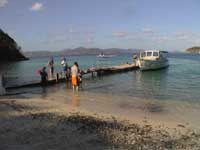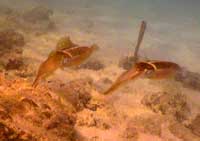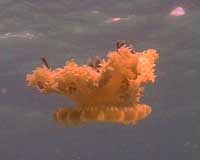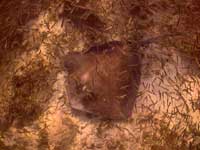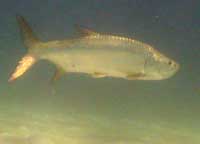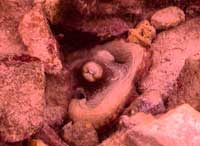 |
|||||||||||||||||||||||||
We have left Yorktown Clipper back at the dock in Road Town, Tortola. We are taking a small boat to Peter Island. Peter Island is only a few miles from Tortola. Peter Island is next to Salt Island where we dove on the wreck of the R.M.S. Rhone (Day 3). Today we are going snorkeling to explore the coral reef at Great Harbor. (Great Harbor was where R.M.S. Rhone was anchored before it tried to get away from a hurricane and sank.) We arrive at Great Harbor in the morning and tie up our boat on a small wooden dock. We see that we are the only ones here! Our student explorers have come to explore the reefs with us. The sea in the harbor is flat calm which makes it easy for us to get in the water from the sandy beach. With our masks, snorkels and fins on we wade out into knee-deep water next to the dock. We put our faces in the water and are surprised at what are looking back at us! It's a small school (about 8) of small reef squid (about 6-8 inches long)! They seem as surprised to see us as we are to see them. They are not jetting away, but they are using their side fins to hover off the sandy bottom and watch us. We swim up to the squid, but they only let us get about 4 feet away before they slowly start to swim away. We know why the squid are very nervous about us. They know that they are the favorite food of many of the larger underwater animals. They may be worried about us trying to catch them. The squid are changing color as we watch them. They go from a very pale, almost white to a dark brown in seconds. Then, as they get more relaxed with us being there their bodies have a tint of iridescent pink and green. We watch amazed as the iridescent colors of the squid pulse from pale to bright. Squid are a related to octopuses. Both of these animals are cephalopods. Cephal is a ancient Greek word that means "head". Pod is another Greek word that means "foot". These animals are called "head-foot" because their legs grow right out of their heads! After watching the squid for a long time do their funny pulsing- colors show we continue our swim toward the reef. We are snorkeling slowly when we see something on the sandy bottom about 20 feet below us. It is round and looks kind of fluffy or bubbly. We swim down for a closer look. It is an upside-down jellyfish! Upside-down jellyfish are upside down because they have plant cells in their bubbly tentacles. They live in shallow water upside-down so the sun can shine on their tentacles and produce food from their plant cells. We carefully stick our hands under the jellyfish and pick it up. We don't want to be stung by the stinging cells of the upside-down tentacles. The stingers protect the jellyfish from being eaten and allow it catch small fish to eat. We slowly bring the jellyfish up close to the surface and let it go to watch what it does. It swims upside-down back down to the sandy bottom! As we swim along we hear what sounds like kids doing cannonballs in the water. We look up to see big brown pelicans diving straight down from the sky into the sea ahead of us. We quickly swim ahead to see what is getting the pelicans all excited. As we get closer to where the pelicans are diving the sea ahead of us becomes dark. It is a huge school of tiny bait fish about 2 inches long! The pelicans are dive bombing this school to scoop up all the fish their big beaks can hold! As we get closer to this school of fish we discover that this school and the pelicans have attracted some other visitors. We have swum into the school of fish and it is like a cloud around us. All we can see are fish moving all around us! There are so many fish moving all around watching them is actually making us dizzy! Suddenly the school opens up under us. A big sting ray (about 4 feet across) swims right under us! Here's what we figured out is happening...When the pelicans dive in to catch the fish some of the fish drop out of their beaks before they can close their beaks. These stunned fish sink the bottom. The stingrays swim across the bottom under the diving pelicans and gobble up the fish laying on the bottom! Now the school suddenly parts next to us and a huge fish swims by! This fish is about 4 1/2 feet long! It is a big tarpon like the tarpon we saw at Anegada Island (Day 8) a few days ago. The tarpon is here for the small fish, too. As we watch the school part again and again we count at least 5 tarpon swimming in and out of the school. Even though they are big, scary-looking fish we know they will not bother us. We finally swim through the other side of this school of fish. We are near a rocky point on one side of Great Harbor. The water where we are swimming now is only about 8 feet deep. No big corals here. The reef is mostly rocks covered with small clumps of corals. In among the rocks we see a small pile of shells. We know what this is! It is an octopus trash dump. Octopuses eat snails. They pull the snails out of their shells and eat them. The octopuses eat the soft snails, but not the hard shells. The octopus usually brings the snails back to its home to eat them. After it pulls the snails out of their shells it leaves the shells outside of its home. After a while the octopus has a pile of shells. When we see a pile of shells underwater we know that an octopus has a home nearby. In a hole under some rocks we see two eyes watching us. It is the octopus! It is very well camouflaged among the rocks. It is curious about us, but it is also nervous about us, too. The octopus is not sure what we are doing. The octopus is probably only about 10 inches long and to him we probably look like some big, scary monsters! The octopus does not hide back inside his hole. He just sits at the entrance and watches us as we watch him. Finally we wave good-bye to the octopus as we swim away.
It is time for lunch. There is nothing to eat here, so we have to take the small boat back to Yorktown for lunch. We did not have time to explore the coral reef on the other side of Great Harbor, so we will come back here after lunch to explore the coral reef then.
Best Fishes, |
TODAY'S DATA Great Harbor, Peter Island, BVI Position: 18º 22' N / 64º 34' W Great Harbor, Peter Island, BVI. We are going into the water right next to the dock to see what we can find underwater. (Karen is standing in the water at the left end of the dock, wearing the black wet suit and holding her pink fins.)
These reef squid (about 8 inches long) seem to be as curious about us as we are about them.
This is the upside-down jellyfish we found. Unlike all other jellyfish it swims with it tentacles sticking up toward the surface of the sea.
Swimming through this huge school of tiny bait fish we see this big stingray (about 4 feet long). It is looking for stunned fish laying on the bottom.
This big tarpon swims just outside of the school of bait fish.
We found this octopus (about 10 inches long) watching us from the entrance to his home. |
||||||||||||||||||||||||
home | basecamp | archives | library | other expeditions | kids' page | contact us © 2003, The Ocean Adventure All rights reserved. |
